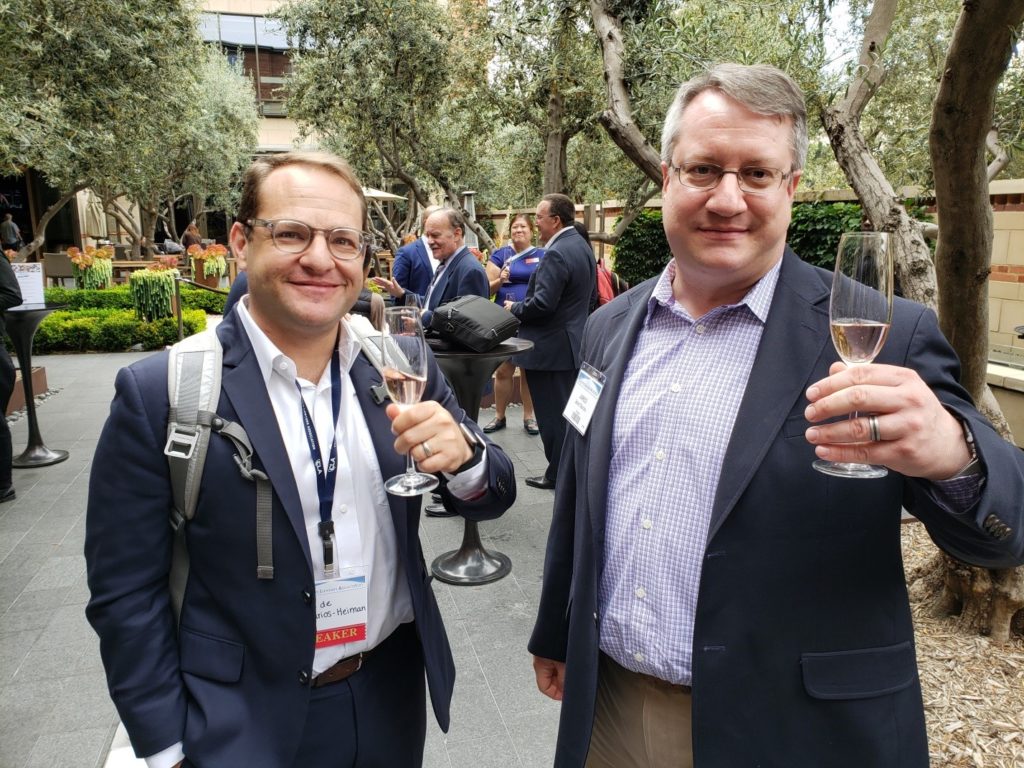Intellectual Property Law
IP Section Internet Conference: Review by Susan Poorman
IP Section Internet Conference, June 2019
IP Section Reporter: Susan Poorman
Review of Keynote Talk
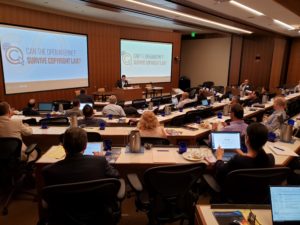
Mike Masnick, founder of TechDirt, opened up the 2019 IP and the Internet conference by reassuring his audience that he isn’t actually anti-copyright. And to be sure, many of his entertaining slides clearly displayed Unsplash or Creative Commons attribution. But just in case his audience turned surly, one of those 487 (down from the original 489) slides showed the escape route he had mapped out to LAX.
His big question was, Can an open Internet and copyright law co-exist? His answer was essentially yes, but not without some changes that take into account technical innovations and their impact on the culture. He compared copyright law to a “duct tape law,” under which new rights and licenses are grafted onto existing law in a manner that makes sense at the time but becomes laughable in retrospect. A stellar example is the player piano: provisions enacted to deal with a technology now confined to novelty restaurants and amusement arcades are still influencing music delivered by 21st century technology.
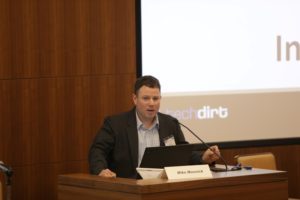
But his much greater concern was with Article 13 of the new EU Copyright Directive. This article, he claimed, would render a fundamental change in how the Internet works by requiring every platform to license every piece of content that is under copyright. One of the primary purposes of copyright is to provide an incentive to create. But as Masnick pointed out, every day thousands of people may post a tweet about a beautiful sunrise they witnessed. Do such tweets need the incentive of copyright protection for people to write and share them? On the contrary, he emphasized, the need to obtain permission to communicate works against the incentive to create. Since there is more content all the time, he suggested it might be time to rethink the copyright system entirely. Use copyright as an incentive when necessary; use an alternative system like Patreon or crowdfunding when those work better. He admitted in response to a question that, although he creates content to be shared, he does react when someone else uses it without giving him any credit. But that hasn’t kept him from creating. Whether he tweets about the sunrise or not, he didn’t say.
Review of Music Modernization Act Panel
The Music Modernization Act of 2018 is being called the biggest change in copyright law in a decade. During the second session of the IP and the Internet conference, three intrepid guides did their best to lead the rest of us through the thickets of these momentous changes.

First, Prof. Tyler Ochoa walked us through the three titles of the Act. The first title will create a new blanket license for musical works (but not sound recordings) to be used by digital music providers, with a mechanical licensing collective (MLC) to administer it. The MLC will in turn establish a musical works database to aid in the distribution of royalties to the appropriate parties, with provision made for “orphan” works whose copyright owners are unknown.
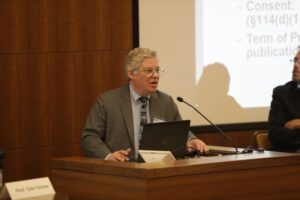
The second title will offer new federal protection for sound recordings fixed before February 15, 1972. This will be a sort of “para-copyright” protection, offering remedies for infringement but no criminal remedies, and will give works which could not receive any sort of protection when first published a chance to make some money now. As with all matters copyright, dates are very important, and rights holders and the attorneys who love them will need to pay strict attention to the complicated scheme regulating when works enter the public domain.
Finally, the third title will authorize SoundExchange to accept voluntary letters of direction from artists to distribute royalties from sound recordings to producers, mixers, and sound engineers.
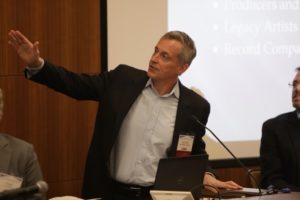
Then George Borkowski discussed the events which led to the passage of the Act in a little more detail. He used the familiar metaphor of comparing the process to sausage-making, but in actuality it didn’t sound nearly as unappetizing. He credited both Sen. Orrin Hatch, long a friend of the music industry and himself a songwriter, and a rare consensus among the all various interests involved, artists and industry folk alike, with making it happen. Songwriters came together in a public campaign for the Act, especially the estates of legacy artists, who often earned little or nothing from their hits. And the campaign was a success, because it led to an even rarer occurrence in this contentious political environment—unanimous passage by both houses of Congress.
To conclude, Brad Prendergast, an attorney with SoundExchange, filled us in on some of the details. Passage of the Act took a lot of compromise because Congress simply didn’t want to get involved until consensus had been achieved. He explained a little more about the blanket license, which is compulsory—rights holders can’t say no or ask to be excluded, but they do receive remuneration for the use of their works. As a practical matter, he noted that, just as Title II will be offering something like copyright protection, inclusion of musical works in the new database will be analogous to copyright registration, but it will not be actual registration. Still, although it may take a little more effort, rights holders will be able to get something they couldn’t get before.
In addition, he elaborated on SoundExchange’s role in distributing royalties. Title III, the Amp Act, merely codifies SoundExchange’s already existing practice of using letters of direction to transfer royalties to producers, mixer, and sound engineers. Music providers will now be able to obtain safe harbor from infringement of state copyright laws by making such payments. However, since most of them were already making payments, because they couldn’t always be sure which recordings were pre-1972, the actual impact of the law in that respect will be minor. Nevertheless, he believes that the database established by the new law is an important step in public access to information about musical works.
Now if we could just get the songwriters to take over the rest of the government.
Review of Luncheon Table Topics
At our lunch table we were fortunate to have as our table speaker and moderator Adriana Sanford, a cyber security expert and frequent commentator on CNN. Our table topic was cyberthreats, but Ms. Sanford focused on the hazards inherent in digital communication on an international level. She emphasized that the key concept to keep in mind is non-compliance—if you work with other countries, even with other states, you will at some point be non-compliant. Because of the complexity of working across multiple jurisdictions and the constantly evolving nature of both technology and the laws dealing with it, an attorney has a perpetual responsibility to keep up with every aspect of what’s going on in both the legal and tech spheres and the intersection between them, a daunting prospect in itself. But because of that same constant change, it’s impossible to do. This is the challenge she presented us with.

Despite the direness of her warning that non-compliance was inevitable, Ms. Sanford wasn’t ready to let us off the hook and adopt a casual attitude to it, but she did offer a few tips for navigating the hazardous tracks of cyberspace. First, she gave us a piece of advice that seemed overly simple at first: Don’t assume that, because you have learned the laws of one country, you then know the laws of another country. At first glance, this should be obvious to any lawyer, but, in an age when instant global communication often gives the misleading impression that national differences have been eroded and the customs of cyberspace overrule more traditional customs, it might be overlooked by even sophisticated practitioners. Secondly, in addition to making sure that you are familiar with the applicable laws, she told us to be prepared to find that sometimes the laws just won’t make sense. Some governments don’t contain members who understand how tech works, don’t have credible advisors on the subject, don’t listen to their advisors, and will pass laws that don’t actually work in the real world. Finally, of course, there is the classic issue that arises when working across borders: beware of the conflict of laws. Ms. Sanford said to be especially careful about going in-house overseas and referred us to Cathy’s Quandary, the hypothetical about a California attorney faced with a dilemma over differing money laundering laws while representing an Italian couple in a real estate transaction. Trying to do the right thing in one jurisdiction can land you in hot water in another, because ethics as well as laws may differ. Until the laws are aligned, she counseled, follow morality.
Review of CCPA Panel
After lunch we were able to learn a little something about the new California Consumer Privacy Act, expected to become effective on January 1, 2020. Josh de Larios-Heiman gave us an overview of the Act, explaining that it’s designed to show that California takes privacy seriously, so the EU won’t attack our tech companies. He gave us a few definitions to illustrate the extent of the law: all natural persons who are California residents or domiciliaries will be protected. The personal information to be protected will include any information that identifies, relates to, describes, is capable of being associated with, or could reasonably be linked, either directly or indirectly, with a particular consumer or household, although “household” isn’t defined. What is construed as personal may be context-dependent at times but he said to tread carefully with any exceptions—treat everything as private. The Act doesn’t apply to publicly available information, aggregated or de-identified information. As with “household,” there is no clear definition of “de-identification,” but essentially it is information that cannot be tracked back to an individual.
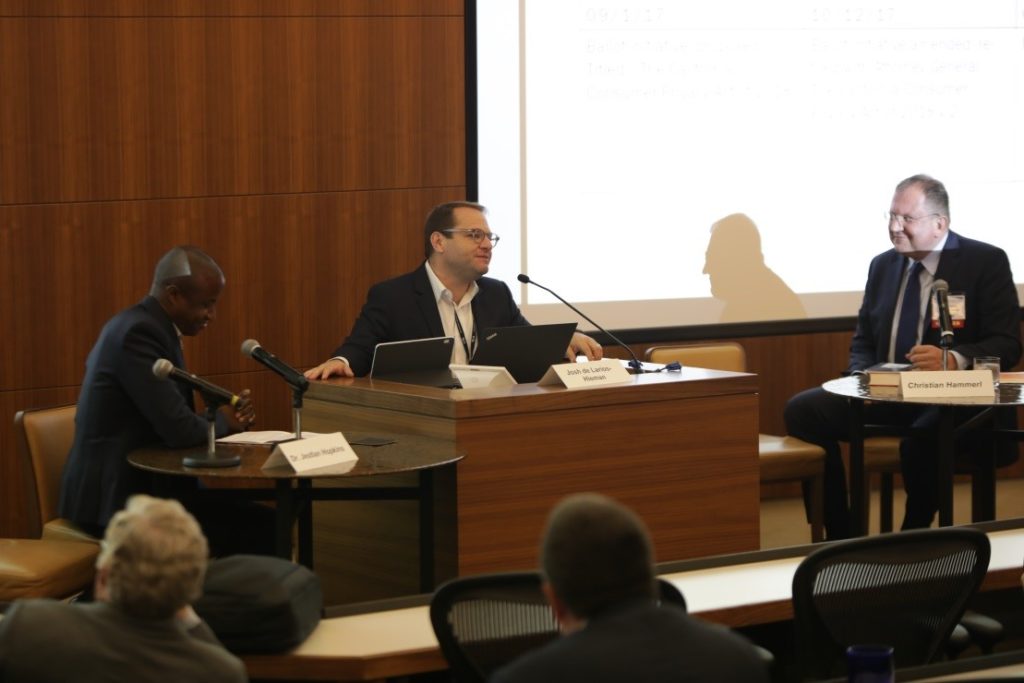
In general, the rights consumers will get under the new law will be the right to access their personal information, the right to delete information, and the right to say no, opting out of data sales. There will also be a right not to be discriminated against, meaning consumers won’t be penalized for withholding certain data unless there is a quid pro quo. However, any private right of action is currently severely limited.
Then Dr. Jestian Hopkins elaborated a little more on the Right to Know as it pertains to the selling and disclosure of information. The wider the definition of personal information, the greater the weight of the Right to Know. Any organization collecting consumer information must conduct a data inventory and select a request mechanism, so Dr. Hopkins recommended using data collection as a branding opportunity to show how you communicate with consumers. In an era when privacy itself seems in danger of becoming a quaint relic of the past like quill pens and hoop skirts, using a little extra care in handling could go a long way in creating consumer confidence.
Review of Online Wine Sales Panel
As many people like to do, we capped off the day at the IP and the Internet conference with a little wine. Rachel Corcoran, General Counsel of online wine marketing place Drinks.com, spoke to us about Direct to Consumer (DTC) sales, the newest method of reaching wine consumers and also the one showing the most growth. Like a lot of new business and marketing platforms, online wine sales are subject to laws that were enacted when current methods of reaching customers weren’t even the stuff of science fiction, and therein lie the issues. In the case of wine, the laws date back to Prohibition, a social experiment that can be described in three words: it didn’t work. As with many of the more colorful periods of history, there are always more fun stories than we learn in school, and Corcoran shared a few of the clever ways alcohol producers found to get around the law, including the sale of wine bricks. These were bricks of the still completely legal concentrated grape juice, packaged with a very clear warning not to dissolve the brick in water and leave the solution in a cool, dark place for 21 days, or it might turn into wine. She didn’t mention if any federal agency kept records of how much accidental fermentation may have resulted from failure to heed these warnings.
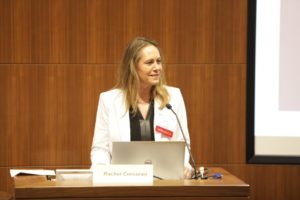
The repeal of Prohibition in 1933 took effect immediately in only 18 states, and other states remained free to continue to forbid alcohol sales within their borders. The result was a patchwork of laws and a three-tier system of producers, distributors/wholesalers, and retailers. Each level could only sell to the next lowest level, retailers could only sell to consumers, and no entity could have ownership on more than one level. The government could thus prevent any one level from gaining too much control and at the same time preserve a profitable tax scheme. Obviously, this panoply of regulations later affected interstate online wine sales.
But in 2005’s Granholm v. Heald, the Supreme Court ruled that Michigan and New York laws banning DTC sales for out-of-state wineries only violated the dormant Commerce Clause of the Constitution. That decision opened the way for expanded sales, and now 40 states have direct shipping to out-of-state consumers, three states and the District of Columbia have limited shipping, and seven still prohibit it.
This final session of the day was followed by a reception on the conference center patio, hosted by Drinks.com and featuring several refreshing wines. It was a lovely and relaxing way to end a fascinating day.
